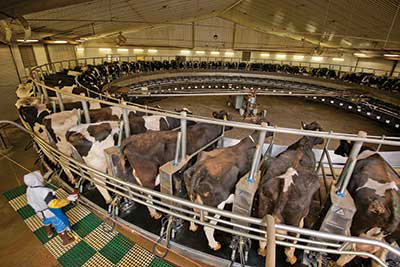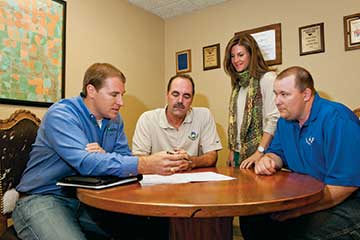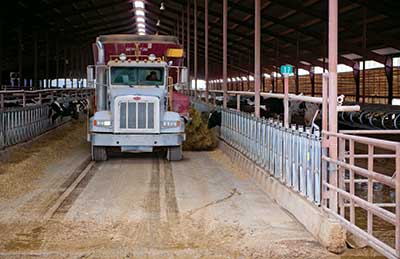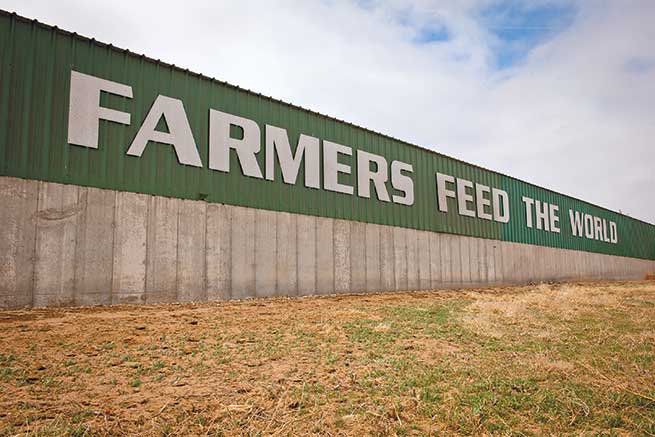
Margret and Harry DeWit
Photos by Artie Limmer
When a young accountant named Margret accepted the marriage proposal of dairy herdsman Harry DeWit more than two decades ago, she knew their future together would involve milking cows.
At the time, Harry was working on a dairy farm in Southern California and itching to have his own dairy herd. Since moving from Holland to Canada and then to California in 1987, he’d been saving his wages with the goal of buying a dairy operation.
“I knew we were going to have our own dairy farm somewhere,” says Margret, who was introduced to the ambitious Harry while visiting California from Holland. “But at that point we didn’t know where it would be.”

Nor did she have any idea how large that future dairy operation would be.
Now, 21 years later, the couple owns and operates High Plains Dairy, located near Friona, Texas, on the flat, wide-open plains an hour’s drive southwest of Amarillo. Here, they milk 4,500 to 4,700 cows that produce enough milk to meet the equivalent of the City of Lubbock’s dairy needs every day.
While the size of the dairy may impress international guests and children visiting on school trips, it’s the DeWits’ leadership and innovative farming practices such as their cross-ventilated barn that has earned them widespread respect in the dairy industry.
Innovative Dairy Farmers of the Year
In 2009, Harry received the 11th annual Innovative Dairy Farmer of the Year award, sponsored by the International Dairy Foods Association and Dairy Today. He is a former board member of the Texas Association of Dairymen.
“High Plains Dairy is one of the most progressive dairies in the Southwest,” says their loan officer, Phil Peabody, relationship manager with Capital Farm Credit in Lubbock. “It’s successful because of Harry and Margret’s outstanding management skills, attention to detail, strong work ethic and ability to focus on their long-term goals.”
Harry admits he has always been goal-focused and “blessed with business instincts.” Reared on a 32-cow dairy, he realized as a teenager that it would be difficult to acquire his own dairy farm in Holland due to a tight regulatory environment and land shortage, so he set his sights abroad. After studying animal science in college, he worked for a short time on a Canadian dairy farm before landing a job at a dairy operation in California.
“The one thing I wanted when I immigrated was the opportunity to dairy for myself,” he says. His ideal size was 1,000 cows or more. “With money we saved up, we wanted to buy cows somewhere — but we couldn’t afford California.”
An Opportunity in Texas
In 1992, the year that he and Margret married, he was hired as the herdsman for a Stephenville, Texas, dairy, where he was able to lease space to milk 150 cows of his own. The following year, he leased a larger place and expanded the herd to 250 cows. By 1996, the DeWits were milking 650 cows. Five years later, the herd exceeded 2,000 cows on three leased farms — double Harry’s original target. Still, he had not accomplished his long-term goal: to own his own dairy farm.
HIGH PLAINS DAIRY
Location: Friona, TX
Herd size: 10,3000 head, including cows and heifers
No. of milking cows: 4,500-4,700
Total annual milk production: More than 120 million pounds per year
Average daily milk production:73-77 pounds per cow per day
Farm size: 6,000 acres
No. of employees: 50
Feed requirements: 128,000 tons anually

The dairy's 4,500 Holstein cows are milked twice a day in a rotary milking parlor. The carousel holds 72 cows.
Finally, in 2002, the couple moved their four children, 2,150 cows and 10 employees to West Texas, and began building High Plains Dairy on a section of land they’d purchased southeast of Friona. Here, in an area dominated by feedyards, they constructed a combination of free-stall and open-lot housing, installed a rotary milking parlor and began growing some of their own feed. For the next several years, they continued to build equity and buy more land, financing nearly every land purchase through Farm Credit. As they added land, they also expanded the dairy herd and hired more employees.
By 2007, the herd was significantly larger and milk prices were up. The time was right to invest further in the operation. The DeWits chose to build a state-of-the-art cross-ventilated barn — one of the first in Texas. They also added silage pits and hay barns and upgraded the farm’s waste management system, which is designed to avoid surface water discharge and recycle waste components.
With these improvements complete, the farm added even more cows and switched from a three-times-a-day milking schedule to twice a day. “You can milk more cows and produce more milk with this schedule,” Harry claims.

Capital Farm Credit Relationship Manager, Phil Peabody, left, reviews a spreadsheet with High Plains Dairy representatives, CEO Harry DeWit, center, Controller Angela Baker and Chief Financial Officer Josh McDonald.
430 Cows an Hour
The 72-cow rotary milking parlor handles 430 cows an hour. Every eight seconds, a cow steps off and another steps on. Milking takes eight minutes per cow, and the milk is piped to a central collection point, where it is filtered and flash-cooled to 36 degrees.
Six or seven truckloads of milk leave High Plains Dairy every day, headed for Select Milk Producers’ cooperative in New Mexico, where Harry is a director. From there, half of their milk goes to Southwest Cheese Plant in Clovis, N.M., and the other half goes to the fluid milk market in Arkansas, Louisiana and Mississippi.
Today, High Plains Dairy raises all of its own replacement heifers. Milking cows, dry cows, heifers and calves total 10,300 head. With a herd that size, feed is a key expense.
“There’s so much money going through here,” Harry comments, noting that 32 truckloads of various rations are mixed daily for the herd. The DeWits have reduced their feed bill, however, by growing a large percentage of their feed.
The farm includes 1,800 acres of wheat, 1,700 acres of corn, 600 acres of sorghum and 400 acres of alfalfa. In addition, there’s another 400 acres of grass. While cotton burs are purchased locally, 90 percent of the dairy’s alfalfa hay comes from Colorado and Kansas.
“We don’t set the milk price, so we have to control our costs,” Harry emphasizes. He works with a buying agent who hedges both their feed and milk.

Feed is distributed in the special needs barn. The herd consumes 32 truckloads of feed daily.
Recycling the Waste
The DeWits are committed to recycling the dairy’s waste as a sustainable, efficient practice. Manure is flushed from pens and carried to a sand separation cell and then to a lagoon. While 90 percent of the sand bedding is recovered, the lagoon water is recycled for the flush cycle in the barns or is run through the center-pivot to irrigate crops. The solids are dried and applied as fertilizer, as well, thereby saving on input costs.
According to Harry, the difference between High Plains Dairy and other dairies is in the details. “Our motto is, ‘If you can’t measure it, you can’t manage it,’” he says. “If you can manage it, you can set goals.” The dairy uses a software system that measures metrics at every step in the business.
“Harry is always looking for ways to do things better,” says Controller Angela Baker. “He doesn’t limit himself to conventional thinking.”
Planning for Tough Times
However, in an industry that can experience wide market fluctuations, Harry cautions that producers should plan for the tough times. “Many people are spread too thin or don’t have enough equity or grow too quickly,” he says.
While Angela is one of the newer team members at High Plains Dairy, the DeWits are proud that many of their 50 full-time employees have worked with them for years. They’ve even had one employee retire. “When you get to a certain size, it’s all about the people you work with,” says Harry.
Knowing they have a reliable, professional team allows Margret, who serves as treasurer, and Harry to spend time on other business interests. Harry, for instance, regularly travels to Stephenville, to check on a dairy they own in that community, and to Ohio, where they are involved in yet another dairy.
The couple hopes they will have many more employees stay with them long enough to retire, because with three teenagers and an 11-year-old who may want to farm, they intend to be in business for many years to come. Their next goal is simple, says Harry: “To keep growing and having fun.”
- Staff

A fence sign proclaims the DeWit family's farming pride
Milk Producers Launch New Power Drink
When a dairy cooperative and the Coca-Cola Co. collaborate, you can bet there’s a milk beverage involved. In early May, Select Milk Producers and Coca-Cola officials held a press conference at Caprock Farms II at Amherst, Texas, to announce the product.
The two organizations have teamed up to produce and market Core Power, a high-protein, lactose-free milk drink they believe will appeal to athletes and fitness enthusiasts. Made with 100 percent real milk, Core Power will have a nine-month shelf life and does not need to be refrigerated. It comes in several flavors.
Caprock Farms II — a strategic alliance between Harry and Margret DeWit and David, Jan and Michael Lawrence — is a member of Select Milk Producers. Select markets milk for 92 Texas, New Mexico and Midwest dairies, and Harry serves on the cooperative’s board of directors.
Cows Have It "Made in the Shade"
On the Texas High Plains, temperatures can easily top 100 degrees on a mid-summer’s day and crash to the teens on a winter’s night. For a dairy cow that’s expected to pump out 73 pounds of milk a day, blizzards and heat waves can impede peak performance.
The milking cows at High Plains Dairy, however, have life made in shade — literally and figuratively. Year-round, they live comfortably under roof in a cross-ventilated barn, in which temperatures never drop below 30 or exceed 75 degrees.
One of the first cross-ventilated dairy barns in Texas, it has had a positive impact on herd health, milk production and productivity, according to owner Harry DeWit. He notes that temperatures, air speed and lighting are all controlled by fans and cooling pads. Odors are minimized by the circulating air, which is refreshed every 80 seconds.
You could also say life is a walk on the beach for the cows at High Plains. The open barn is bedded with sand, which provides the cattle with a comfortable place to rest. “When a cow lies down on a comfortable surface, it will run 40 percent more blood through the udder and produce more milk than a cow on a hard surface,” Harry reports.
Conscious of cow comfort and herd health, the DeWits also built a “special needs” barn that serves as a maternity ward, hospital and veterinary treatment area.